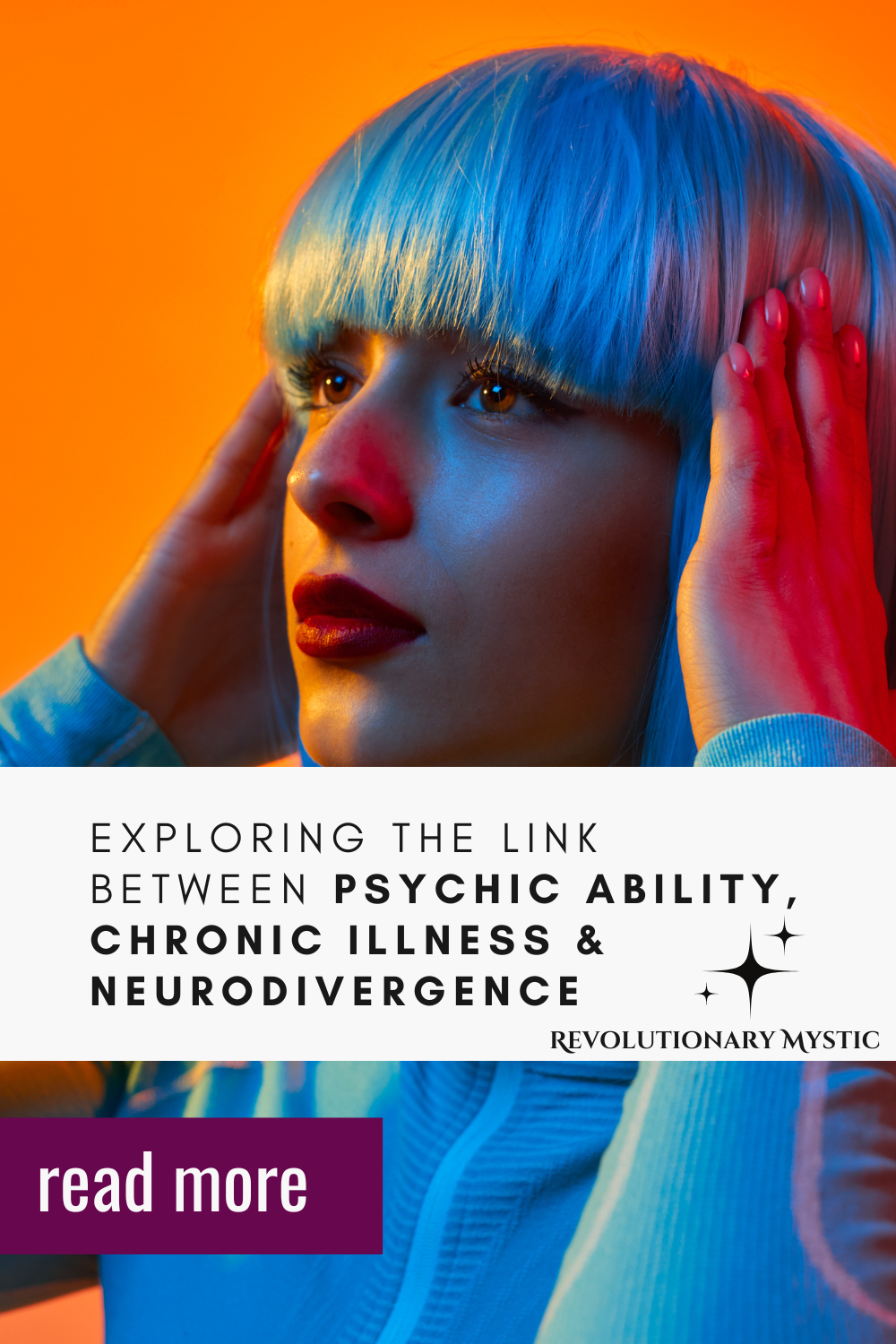Exploring the Neurodivergent, Chronically Ill, and Highly Sensitive Person Venn Diagram
In recent years, increasing attention has been given to the overlap between neurodivergence (such as ADHD and Autism), chronic illness (such as Ehlers-Danlos Syndrome - EDS), and high sensitivity (such as being an empath, Highly Sensitive Person - HSP, or having strong intuitive and psychic abilities). Intriguingly, these traits are frequently seen in individuals assigned female at birth (AFAB). This article delves into the intersections of these characteristics, supported by both scientific research and an intersectional feminist perspective.

Neurodivergence, Chronic Illness, and Intuitive Aptitudes: The Overlap

Intersectional Feminist Perspective: Why AFAB Individuals?
Statistics and Research:Moreover, societal expectations often push AFAB individuals to internalize stress while experiencing disproportionately more traumatic events, which can exacerbate chronic health conditions and neurodivergent traits.
-
According to the CDC, AFAB people are more likely to be diagnosed with autoimmune diseases, which often overlap with chronic illnesses.
-
The Journal of Child Psychology and Psychiatry highlights that AFAB children with ADHD are often underdiagnosed because they present symptoms differently than boys, such as being more internally focused rather than hyperactive.

The Intersection of Underdiagnosis, Misdiagnosis, and Marginalized Identities
Underdiagnosis and Misdiagnosis:
- Girls, women and AFAB people are often underdiagnosed with Autism and ADHD because their symptoms can present differently from the male norm, leading to misconceptions and missed diagnoses.
- Chronic illnesses like EDS are frequently misdiagnosed or dismissed, especially in AFAB individuals, due to gender biases in medical research and practice.
Marginalized Identities: People from lower socioeconomic backgrounds or communities of color often have reduced access to healthcare and face systemic biases, which compound the difficulties in receiving accurate diagnoses and appropriate care.
Practical Implications

My theory: Is Psychic Ability and Mediumship a Type of Neurodivergence?
The question of whether psychic ability and mediumship could be considered a type of neurodivergence is gaining traction in both scientific and spiritual communities. Neurodivergence refers to variations in the human brain regarding sociability, learning, attention, mood, and other mental functions. Recent neurological studies of psychics and mediums provide intriguing insights that support the idea of these "supernatural" abilities having a basis in brain function.Recent Neurological and Brain Studies- Increased Brain Activity in Specific Regions: Studies using functional magnetic resonance imaging (fMRI) have shown that psychics and mediums often exhibit increased activity in specific brain regions during their practices. For instance, research published in Cognitive Neuroscience found heightened activity in the frontal and parietal lobes, which are associated with high-level cognitive functions, such as attention, decision-making, and processing complex sensory input.
- Enhanced Connectivity and Synchronization: Electroencephalogram (EEG) studies have revealed that psychics and mediums often display enhanced connectivity and synchronization between different brain regions. This heightened connectivity may facilitate their ability to process subtle information and make connections that others might not perceive. A study in the Journal of Consciousness Studies highlighted that mediums showed significantly different brainwave patterns when in a trance or during communication with what they identify as spirit entities.
- Theta Brainwaves and Altered States of Consciousness: Research indicates that psychics and mediums frequently enter altered states of consciousness characterized by an increase in theta brainwaves. Theta waves are typically associated with deep meditation, intuition, and access to unconscious material. Studies, such as those published in Frontiers in Psychology, suggest that this state may allow individuals to tap into intuitive or psychic information more readily.
- Neuroplasticity and Sensory Processing: The concept of neuroplasticity—the brain's ability to reorganize itself by forming new neural connections—is another key factor. Psychics and mediums may have brains that are particularly adept at neuroplastic changes, enabling them to develop and refine their abilities over time. Enhanced sensory processing capabilities, akin to those found in highly sensitive people (HSPs), may also play a role in their heightened perceptual awareness.
Evidence from Observation and Neurological Feedback
- Observation: Many documented cases exist where psychics and mediums provide verifiable information about people, places, or events that they could not have known through ordinary means. This observational evidence aligns with the notion that these abilities are genuine and can be witnessed by others.
- Neurological Feedback: Brain imaging and other neurological studies offer a scientific basis for understanding how these abilities manifest. The data from these studies highlight the unique brain functions and structures that support psychic and mediumistic activities.

My Other Theory: Black and Indigenous people Inherently Have Intergenerational Supernatural Abilities Born From Ancestral Knowledgeways and Colonial Trauma
Based on the information provided in this article, my theory is that due to the forced traumas of systemic oppression, global anti-Blackness, anti-Indigeneity, and inherited intergenerational trauma, in addition to our inherited Ancestral knowledgeways and relational spirituality, today’s generations of AFAB, Black, Indigenous, and other marginalized peoples are increasingly and perhaps could be disproportionately found to have neurodivergence, chronic illnesses, and profound intuitive abilities. But with medical racism and systemic neglect, we don't YET have the data to back my claim. However, it's not too big a stretch of the imagination.
The pervasive impact of historical and ongoing systemic violence has left deep imprints on the genetic and psychological makeup of marginalized communities. Epigenetically, the trauma experienced by our ancestors influences our present-day health and cognitive patterns, manifesting in ways that science is only beginning to understand.
This convergence of neurodivergence, chronic illness, and heightened intuitive abilities can be seen as a survival mechanism, a form of adaptive resilience. Marginalized individuals have historically needed to develop keen intuition and sensitivity to navigate and survive oppressive environments.
These abilities, while often pathologized by a Eurocentric medical model, may also be seen as gifts or tools for navigating the world. This perspective challenges the notion of neurodivergence and chronic illness as purely deficits and instead frames them within the context of resilience and survival. Understanding this interconnectedness can foster a more compassionate and holistic approach to health and spirituality, recognizing the strengths and wisdom embedded within marginalized communities.

Photo by Franssy Acosta - Pexels
Decolonial and Indigenous Perspectives on Psychic Ability, Mediumship, and Neurodivergence
Metaphysical and Spiritual Understanding
In many Indigenous cultures, psychic abilities and mediumship are seen as natural and integral aspects of human experience. These abilities are often understood as gifts or skills that allow individuals to connect with the spiritual world, communicate with ancestors, and perceive energies that are not visible to the ordinary senses.- Holistic View of Health and Abilities: Indigenous traditions typically adopt a holistic view of health and human abilities, where mental, physical, spiritual, and emotional aspects are interconnected. Neurodivergence, such as heightened sensitivity or unique cognitive patterns, is often recognized as a sign of special spiritual gifts or roles within the community, such as that of a healer, shaman, or seer.
- Energetic and Spiritual Perception: Psychic abilities and mediumship are understood as forms of heightened perception that enable individuals to sense and interpret subtle energies, spirits, and otherworldly phenomena. This aligns with scientific observations of enhanced sensory processing and brain activity in certain regions.
Scientific Understanding
The scientific approach to psychic ability, mediumship, and neurodivergence focuses on observable phenomena and measurable data. Recent neurological studies have provided insights into how these abilities manifest in the brain, offering a framework to understand them from a biological and psychological perspective.- Neurological and Cognitive Functioning: Studies have shown that psychics and mediums often exhibit increased brain activity in areas associated with cognitive processing, attention, and sensory perception. Enhanced connectivity between brain regions and the presence of specific brainwave patterns further support the existence of these abilities.
- Neurodivergence as an Asset: Scientific research into neurodivergence highlights how variations in brain structure and function can lead to unique talents and perspectives. This is similar to Indigenous views that regard neurodivergent individuals as having special abilities or roles.

Bridging the Perspectives
- Common Observations: Both perspectives observe enhanced perceptual abilities, unique cognitive patterns, and heightened sensitivity among individuals with these traits. Indigenous teachings describe these as spiritual gifts, while science explains them through brain activity and neuroplasticity.
- Integration and Acceptance: Decolonial and Indigenous perspectives encourage the integration of spiritual and scientific understandings. By recognizing the validity of both approaches, we can foster a more inclusive and holistic view of human potential and experience.
Though Westernized society often views spirituality and science as oppositions in direct conflict or contradiction with eachother, the decolonial and Indigenous perspectives on psychic ability, mediumship, and neurodivergence offer a complementary lens to scientific understanding.Both approaches observe and validate the same phenomena, providing a richer and more nuanced appreciation of these extraordinary human capacities. This integration of perspectives encourages respect for Indigenous knowledge systems while advancing scientific inquiry, ultimately enriching our collective understanding.

Support for Misdiagnosis and Under-diagnosis
- AANE (Asperger/Autism Network): Provides resources for adults seeking late diagnosis of autism.
- ADDitude Magazine: Offers tools and articles for ADHD self-assessment and management.
- Mighty Well: An online community for chronic illness patients, providing resources and support.
- Ehlers-Danlos Society: Information and support for those suspecting Ehlers-Danlos Syndrome.
- Autism Self Advocacy Network (ASAN): Resources for self-diagnosis and advocating for neurodivergent rights.
- Books like "NeuroTribes" by Steve Silberman: Offers insight into the history and experience of neurodivergence.
- Online communities like Reddit’s r/ADHD and r/autism: Peer support and shared experiences.
- Patient Advocacy Organizations: Groups like the Patient Advocate Foundation help navigate healthcare systems and advocate for proper diagnosis and treatment.
- Mental Health America’s Screening Tools: Free online screenings for various mental health conditions, including ADHD and anxiety.
Enjoyed this article? Support us on Patreon!
-
Neurological and Brain Studies of Psychics and Mediums:
- Newberg, A. B., Wintering, N., Morgan, D., & Waldman, M. R. (2014). The measurement of regional cerebral blood flow during glossolalia: a preliminary SPECT study. Psychiatry Research: Neuroimaging, 213(3), 226-229. This study uses neuroimaging to observe brain activity during spiritual practices.
- Hageman, J. J., Peres, J. F., Moreira-Almeida, A., Caixeta, L., Wickramasekera, I., & Krippner, S. (2010). The neurobiology of trance and mediumship in Brazil. Journal of Nervous and Mental Disease, 198(12), 947-950. This research focuses on the neurobiological aspects of mediumship and trance states.
-
Scientific Understanding of Neurodivergence:
- Silberman, S. (2015). NeuroTribes: The Legacy of Autism and the Future of Neurodiversity. Avery Publishing. This book provides an extensive overview of the neurodiversity movement and the unique cognitive traits associated with neurodivergence.
- Baron-Cohen, S. (2008). Autism and Asperger Syndrome: The facts. Oxford University Press. This work discusses the distinct cognitive patterns and abilities associated with autism and related neurodivergent conditions.
-
Indigenous and Decolonial Perspectives:
- Cajete, G. (2000). Native Science: Natural Laws of Interdependence. Clear Light Publishers. This book explores Indigenous perspectives on interconnectedness and holistic understanding of the natural world.
- Tinker, G. E. (2004). Spirit and Resistance: Political Theology and American Indian Liberation. Fortress Press. This book addresses Indigenous spiritual practices and their integration with social and political activism.
-
Cultural and Historical Contexts of Indigenous Spiritual Practices:
- Harner, M. (1990). The Way of the Shaman. HarperOne. This book provides insights into shamanic practices and spiritual healing in Indigenous cultures.
- Kremer, J. W. (1997). The dark face of heaven: Indigenous African healing in western contexts. Journal of Transpersonal Psychology, 29(2), 105-122. This paper examines Indigenous healing practices and their integration with Western psychological perspectives.



2 commentaires
I agree, these connections are really brilliant. Excited to see what else is on your site!
What a great article – these connections are so fascinating!